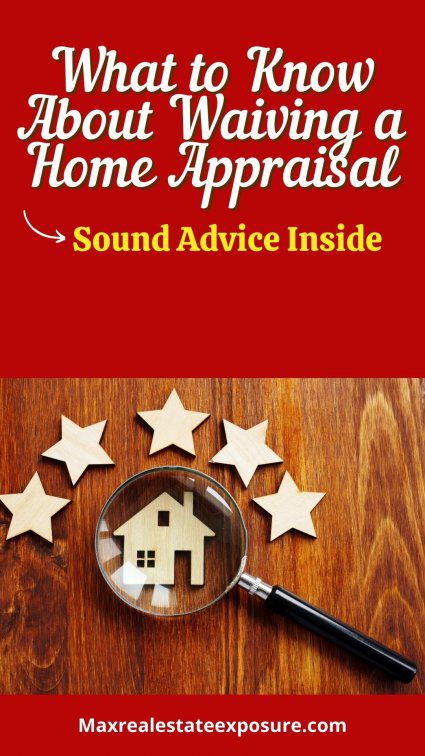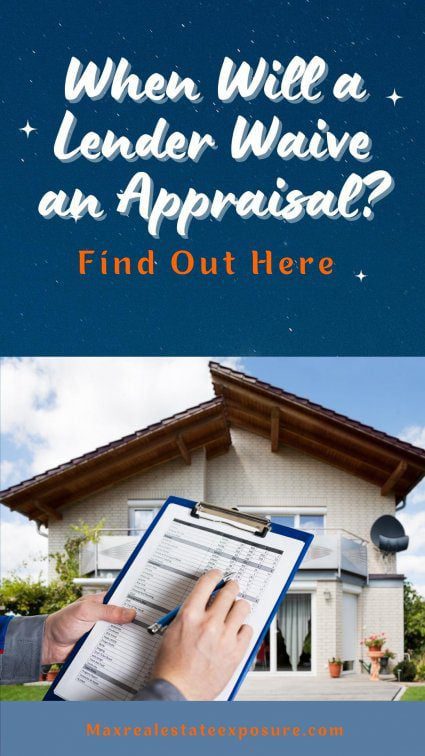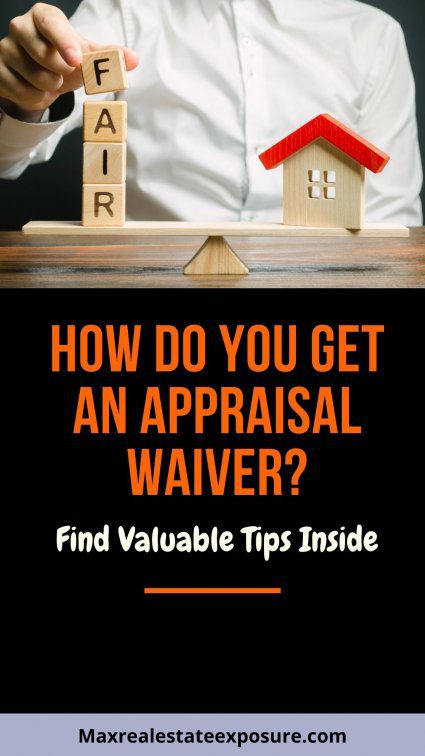Everything You Need to Know About Waiving an Appraisal Contingency

When buying a home, the property appraisal can be a difficult stage. A real estate appraiser will evaluate the property to ensure that the buyer isn’t offering more money than the home is worth.
If the home appraisal comes in lower than hoped, it could spell the end of the purchase unless the buyer can find the difference or renegotiate the purchase price.
A low appraisal can cause an unwanted delay in the process, even if it ultimately doesn’t end.
An appraisal is also an additional cost that the buyer has to cover. But there is another option. You might have heard someone saying you can waive the appraisal.
It is possible to waive appraisal requirements, so an appraiser doesn’t need to visit the property.
An appraisal waiver might seem like a good idea to reduce buying fees, but is this really a good option? Waiving an appraisal isn’t possible for everyone, but it may be for you.
Let’s look at what you need to know about a lender waiving an appraisal.
What Are Appraisal Waivers?
When a buyer has made an offer and the seller has accepted it, the buyer’s lender will need an appraisal. An independent appraiser is used to find the value of the property.
The appraiser will visit the home, check inside and out, and take photographs and measurements. They will then use this information to compare it to recent home sales in the same area. These properties are referred to as comparable sales.
It is very similar to a real estate agent’s process of creating a comparative market analysis to determine a home’s value.
The information should provide a good assessment of what the home is currently worth for the lender. Sometimes the buyer can avoid this stage instead, taking the option of an appraisal waiver.
When waving appraisal requirements, the time it takes to do everything necessary in the home buying process is reduced. Only specific buyers can qualify for a waiver so that an in-person appraisal isn’t needed.
Automated Underwriting Systems Can Calculate The Appraised Value
When an in-person appraisal isn’t used, an automated underwriting service helps determine the property’s value. The desktop appraisal uses data from nearby home sales, known as real estate comps, and any sales data for the home itself.
Using an automated underwriting system to find the home’s value cuts out the regular appraisal costs and the time it takes for this to occur.
If you like the idea of an appraisal waiver, unfortunately, not every buyer or property will qualify. If your lender thinks there are some reasons why an appraisal should still be required, the waiver won’t be approved.
The lender waving appraisal requirements are at their discretion, so even if you think it isn’t necessary, you might not qualify.
If you would like to avoid having a traditional appraisal, you might get the lender waiving appraisal rules to prevent this extra upfront fee. If that happens, your lender will look at the information created by the automated underwriting system instead.
Recent sales data from the same local area will judge the home’s current value.
When Will a Lender Waive an In-Person Appraisal?
 Lenders use the appraisal process to ensure that they are not lending more money than the home is actually worth. The lender doesn’t want to suffer a loss if a borrower defaults on the mortgage.
Lenders use the appraisal process to ensure that they are not lending more money than the home is actually worth. The lender doesn’t want to suffer a loss if a borrower defaults on the mortgage.
A buyer might stop paying the mortgage as agreed, and if it goes on too long, the lender may have to begin foreclosure proceedings. The lender takes ownership of the property that they can sell to recover their losses.
The lender does not want to find themselves in a situation where they have lent $20,000 or $30,000 more than the house is worth.
When they try to sell a foreclosed home, they end up with a loss. While the homeowner will have paid some of that down before defaulting, it won’t make up for the loss if it’s only a few years into the mortgage term.
Despite this possible negative, the lender will waive the appraisal in some situations. Shortly you’ll see how to get appraisal waivers.
Sometimes an Appraisal Isn’t Necessary
If not much time has passed since the last time the home was appraised, there may be no need for a new appraisal. Perhaps the house was only recently purchased, and the conducted examination is still considered accurate enough.
It’s common when refinancing if the last appraisal wasn’t that long ago and there haven’t been significant changes in the market.
Reducing the Underwriting Time
The underwriting process allows the lender to ensure the borrower’s financial situation is good enough to make their monthly mortgage payments.
It also involves the lender checking credit reports and credit scores and ensuring that the home is worth what the buyer will pay.
Without the in-person appraisal, the process will become faster. Shaving possibly two days or even two weeks off the overall underwriting time.
When you remove an appraisal, the opportunity to close sooner will likely be possible.
How to Get an Appraisal Waiver
 You may be wondering how to get a lender to waive an appraisal?
You may be wondering how to get a lender to waive an appraisal?
To have a chance at an appraisal waiver, you’ll need to use a lender working with Fannie Mae’s or Freddie Mac’s automated underwriting system. It shouldn’t be too much of a problem as most lenders use these systems.
In the mortgage industry, it is known as a property inspection waiver. These appraisal waivers are only given when you’re financing with a conventional loan.
The kind of appraisal waiver you receive depends on if you’re applying for a loan backed by Freddie Mac or Fannie Mae.
Freddie Mac guidelines have an automated collateral evaluation appraisal waiver given by the Loan Product Advisor automated underwriting system.
Fannie Mae provides their option through the Desktop Underwriting automated underwriting system.
Lenders have different borrower criteria to be considered for waiving appraisal requirements. Though it is likely, you will need to have a good credit score and are financing a one-unit home or condominium.
Most of the time, you’ll also need a 20% down payment, as required by Fannie Mae. However, there are occasional exceptions, like a property classified as being in a high-needs rural location by the Federal Housing Finance Agency.
If that is the case with your property, a down payment of only 3% could be acceptable for a waiver. You can see a map that provides information on the high-needs areas.
The Advantages of an Appraisal Waiver
Not requiring a regular appraisal will save the buyer hundreds of dollars. It should reduce the time it takes for the buyer to close on their home as well.
It might also mean that there is less risk of the appraisal coming in lower than the offer amount, though this will depend on the market conditions.
Potential Downsides When Lenders Waive Appraisal Requirements
If you choose a waiver over an in-person appraisal, you risk paying more for the home than it is worth. Since the appraiser visits the house, they will naturally find things that an automated assessment will never consider. When a real estate appraiser visits a property in person, the appraisal should produce a more accurate home valuation.
The appraiser will be able to better assess the home’s condition, which might mean that it isn’t worth as much as comparable properties. This could lead to a significant difference between the in-person and automated results. In a case like this, saving money on the appraisal won’t look like a great deal if you pay tens of thousands more for the home.
Spending more money on a home than it is worth will never be a great idea. It will mean you are paying more interest back to the lender than you need to, which will mean a difference of thousands of dollars during the mortgage.
When the buyer eventually comes to sell the home, they will have a more challenging time making a good profit. If the market has fallen, they stand to lose even more money than they otherwise would.
No Appraisal Contingency Means No Return of Earnest Money
Many buyers will walk away from the deal if the appraisal report has a lower value than the offer price. When this happens, they can trigger an appraisal contingency to allow them to exit the deal with their earnest money deposit returned.
If there is an appraisal gap, the buyer can also ask the seller to lower the price to meet the appraisal value. If that doesn’t work, they can ask the seller to meet them halfway, and they can always try to make up the difference entirely through their funds.
There can also be problems when you want to refinance if you have paid more than the appraisal value. In comparison, some refinancing loans with the FHA, the VA, and the USDA don’t need appraisals, most will. The lender will want an appraiser to find the current value before approving the refinance loan.
Lenders generally need the homeowner to have 20% equity or more in the property before they will consider approving the refinance application. Lenders will generally expect the difference between what is still owed on the home loan and the amount the home is worth to mean that the borrower has at least 20% ownership.
If you have paid more for a home than it was worth, it will be more difficult to have 20% equity. It will mean you will need to pay the mortgage for longer, with more interest going to the lender before you can refinance.
Competitive Markets Dictate Appraisal Waivers
 In today’s competitive housing market, a buyer may need to waive the appraisal rather than a lender appraisal waiver. With a bidding war being the norm and not the accepting buyers find themselves having to do unusual things, including waiving the appraisal, skipping a home inspection, removing their financing contingency, or even being cash buyers!
In today’s competitive housing market, a buyer may need to waive the appraisal rather than a lender appraisal waiver. With a bidding war being the norm and not the accepting buyers find themselves having to do unusual things, including waiving the appraisal, skipping a home inspection, removing their financing contingency, or even being cash buyers!
Low inventory combined with high demand has caused real estate markets to take off like a rocket ship.
When offering on a house, a buyer has to do everything under the sun to make their offer more attractive. If they don’t, they’ll likely lose the home. Offers are almost always ending up way above the asking price.
When in a multiple offer situation, buyers are now offering to waive their appraisal to make the offer more attractive. It’s a way of trying to compete with cash offers. Appraisal contingencies are one less headache a seller will need to worry about.
You’ll need to lean on your buyer’s agent for guidance on structuring your offer without being too risky.
Low Down Payment Mortgages Such as VA Loans and FHA Loans Don’t Have Appraisal Waivers.
Loans backed by the Federal Housing Administration and The Veteran’s Administration do not have appraisal waivers.
These loan programs have low or no down payment requirements. While you don’t need a large down payment, the value of your home must be consistent with the appraisal.
Buyers don’t have the luxury of waiving appraisals with these loans. The sales price must match the appraised value; otherwise, the borrower will need to make up the difference. Most buyers who use these loan programs don’t have lots of extra cash available.
Due to today’s hot market, many home buyers are locked out of real estate transactions. They find it harder to make a home purchase because many sellers choose offers with higher down payments due to potential appraisal issues.
Think about which loan program will be best before making a loan application or getting preapproved.
Summary of Pros and Cons of an Appraisal Waiver
To waive an appraisal means there are additional risks and rewards. Here is a summary of waiving an assessment.
PROS
- You will save on the expense of paying an appraisal fee.
- There will be no waiting for the appraisal to be completed.
- The loan process will be faster.
- You’ll likely be able to close faster.
- There will be no worry about making the house look great before the appraiser arrives when refinancing.
CONS
- There will not be a neutral third party evaluating the home value.
- The home sale price may be more than you should be paying.
- You’ll be avoiding another set of eyes evaluating any potential problems with the property.
- You can’t back out of the purchase with a low appraisal without an appraisal contingency.
Closing Thoughts
When you buy a home, your finances are often stretched, and any savings you can make will look attractive. While you can save hundreds of dollars when they waive appraisal requirements, it could cost you more in the long run. A lender waived appraisal has advantages and disadvantages.
An appraisal with an appraiser who visits the home will give you some protection from paying too much for your property. It offers you a clearer understanding of whether you have paid the right amount for the home and potentially saving you many thousands on mortgage interest.
About the Author: The above Real Estate information on what waiving an appraisal means was provided by Bill Gassett, a Nationally recognized leader in his field. Bill can be reached via email at billgassett@remaxexec.com or by phone at 508-625-0191. Bill has helped people move in and out of many Metrowest towns for 35+ Years.
Are you thinking of selling your home? I have a passion for Real Estate and love to share my marketing expertise!
I service Real Estate Sales in the following Metrowest MA towns: Ashland, Bellingham, Douglas, Framingham, Franklin, Grafton, Holliston, Hopkinton, Hopedale, Medway, Mendon, Milford, Millbury, Millville, Northborough, Northbridge, Shrewsbury, Southborough, Sutton, Wayland, Westborough, Whitinsville, Worcester, Upton, and Uxbridge MA.

